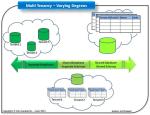Invariably, the logical answer to coping up with Big Data with regards to eDiscovery is Predictive Coding. While definitions of predictive coding vary, but a common form includes uploading electronic documents to a server followed by taking representative samples, and ‘Seed Sets’ are created by attorneys who are familiar with the legal issues of the case. Attorneys, then, review the seed sets and code each document for responsiveness or other attributes, such as privilege or confidentiality. Utilizing a re-iterative approach, predictive coding software is tweaked and adjusted regarding how the computer will analyze future documents.
Recently, a U.S. Tax Court gave permission to use predictive coding in Dynamo Holdings, Ltd. vs. Commissioner, 143 T.C. No. 9 (September, 17, 2014) case, whereby permitting a taxpayer to use predictive coding as a first-pass review of a large set of documents, despite the. Apparently, the big idea is to reduce costs. While respondents in this case asserted predictive coding to be an ‘unproven technology’, the court completely disagreed justifying this by citing several precedents along with an expert testimony. Predictive coding contains two important elements known as ‘Recall’ and ‘Precision’ – I have detailed these concepts in my earlier post. Inspite of this, the court’s opinion is important for taxpayers faced with requests for a substantial amount of ESI, and has the potential to reduce costs that may easily run into millions of dollars.
This reaffirms one thing for sure – IT, which was once considered a necessary evil, is now evolving to form a symbiotic relationship with the legal industry, and with other industries alike. Manual document review is certainly going to be obsolete in the near future – if not already! Analytics, predictive coding, machine learning products and technologies providing us with business intelligence (BI) to make informed decisions. For example, Microsoft’s newest products such as Delve, along with host of BI tools provide meanings to your data, while SharePoint e-Discovery center adheres to the regulatory compliance and standards. With this said, predictive coding technology is essentially replacing manual work, and tech savvy attorneys seem to have a ball with one!
The important aspect in this regard lies with determining the optimal values for ‘recall’ and ‘precision’ within the predictive coding software!
e-Discovery and | cloud computing
New Jersey, USA | Lahore, PAK | Dubai, UAE
www.claydesk.com
(855) – 833 – 7775
(703) – 646 – 3043




![]()
![]()


